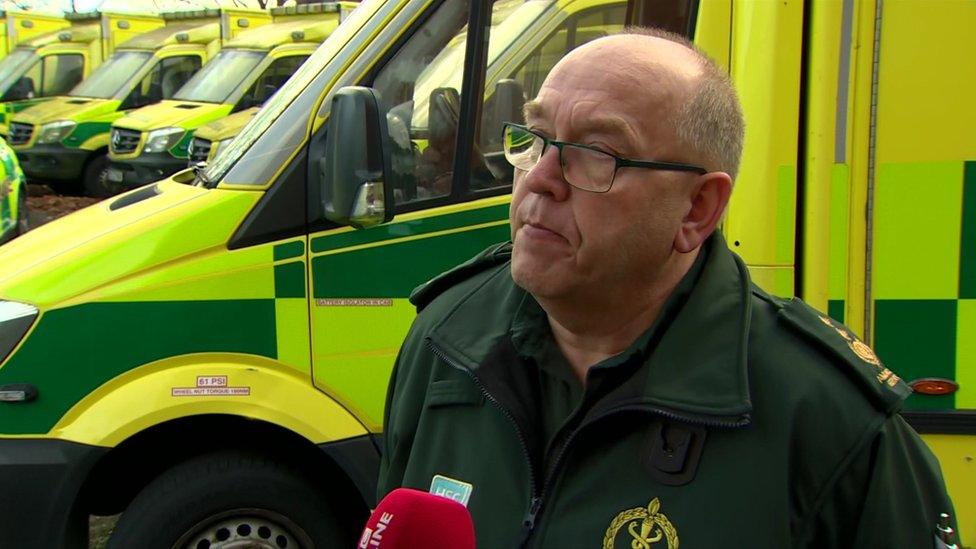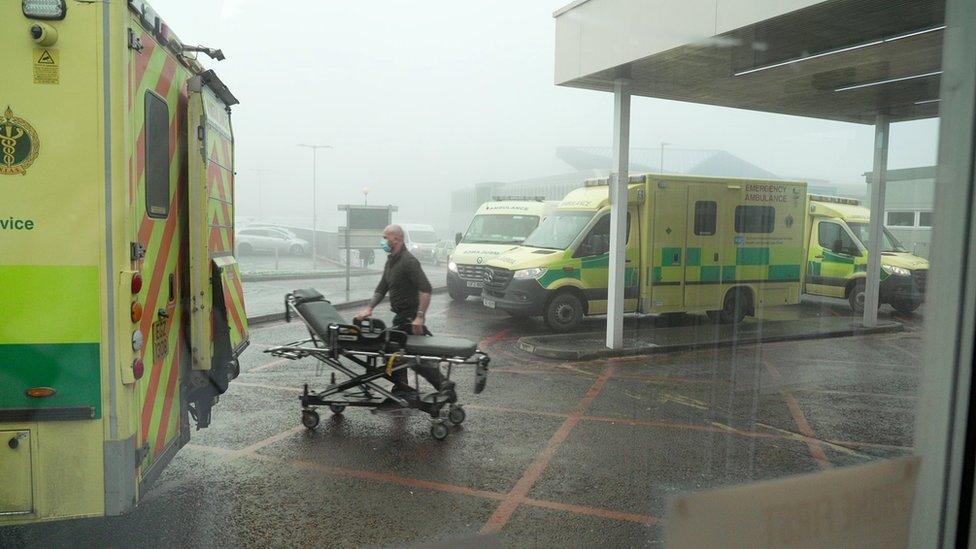NI Ambulance Service at 'highest level of pressure ever'
- Published

The Northern Ireland Ambulance Service (NIAS) is at its "highest level of pressure", with waits of more than 24 hours for some patients.
Assistant Director Mark Cochrane said the service had its busiest ever day on Monday.
One patient waited for more than four days for treatment in an A&E department.
On Wednesday BBC's The Nolan Show reported that a man died after waiting more than nine hours for an ambulance.
It is not clear whether the patient would have survived had an ambulance reached him more quickly.
Mr Cochrane told BBC News NI that the NIAS was "currently operating at our REAP (Resource Escalation Action Plan) Level Four, which is our highest level of escalation".
"Within that, we also have escalated levels based on clinical safety to patients," he added.
"On Monday of this week for example, we moved for the first time ever to our CSP Level Four which is the highest level of pressure that we actually can experience.
"That is the first time ever that we have utilised that particular level of escalation."
'Patients at risk'

Northern Ireland Ambulance Service Assistant Director Mark Cochrane said the service had its busiest ever day on Monday
His comments come as tens of thousands of ambulance workers, including paramedics and call handlers, strike in England and Wales.
The impact will vary by region, but extensive disruption is expected and NHS leaders have warned that patient safety is at risk.
Mr Cochrane said there was "extreme pressure in the system" in Northern Ireland, with "lots of patients waiting for very prolonged periods of time on ambulances".
He said "that puts patients at risk".
"We have had patients who have waited many hours in excess of the performance targets," he added.
"So in terms of our category one patients, they are the most life-threatening, we aim to get to those the quickest, and we have a target of eight minutes.
"But down at the other end of that scale, we have category four patients, who we have three hours to respond to, and they are taking multiple hours, sometimes into 24 hours and beyond."
Health chiefs said that across Northern Ireland's A&E departments at 09:00 BST on Tuesday:
There were 335 patients who could not be given a bed
There were 542 patients waiting for treatment
Of these, 447 had been waiting longer than four hours; 300 had been waiting longer than 12 hours
The longest wait for treatment was 107 hours, 43 minutes
There were 22 ambulances parked outside with patients waiting to enter

Health trusts have announced a new target that ambulance handovers of patients will take no longer than three hours
On Monday, health trust chief executives in Northern Ireland outlined new targets to try to ease pressure, including patients leaving hospital no later than 48 hours after they are medically fit for discharge and where a suitable placement is available.
There will also be a maximum limit of a three-hour wait for ambulance handover.
Hundreds of hospital appointments were cancelled on Tuesday as Northern Ireland's nurses staged a second day of strike action.
The Royal College of Nursing (RCN) has warned of further strikes in the new year, which the Department of Health say would be "catastrophic".
Related topics
- Published21 December 2022

- Published21 December 2022

- Published20 December 2022
